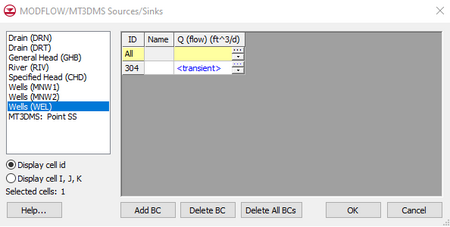GMS:MT3DMS Point Sources/Sinks BC: Difference between revisions
From XMS Wiki
Jump to navigationJump to search
No edit summary |
|||
| (10 intermediate revisions by the same user not shown) | |||
| Line 1: | Line 1: | ||
The [[GMS: | {{MT3DMS Links}} | ||
[[File:MT3DMS PointSourceSinks.png|thumb|450 px|The ''MODFLOW/MT3DMS Source/Sinks'' dialog showing point options for MT3DMS]] | |||
The [[GMS:MT3DMS_Source/Sink_Mixing_Package|''Source/Sink Mixing Package'']] dialog can be used to edit both point and areal sources/sinks using a spreadsheet. In many cases, it is more convenient to view and edit source sink concentrations on a cell-by-cell basis. Two commands are provided to facilitate this type of editing: the '''Point Sources/Sinks''' command and the '''Areal Sources/Sinks''' command. | |||
==Point Sources/Sinks== | ==Point Sources/Sinks== | ||
The | The '''Point Sources/Sinks''' command is used to assign and edit the concentrations at point sources and sinks. Before selecting the '''Point Sources/Sinks''' command, a set of cells should be selected using the cell selection tools. Once the command is selected, the ''MT3DMS Point Source/Sink'' dialog appears. | ||
A point source/sink concentration for each species is assigned to the selected cells by selecting the toggle corresponding to the type of source/sink. The concentration at the cells can be specified as either constant or transient. If a constant value is specified, this number will be used for all stress periods. If the Variable option is used, clicking on the window brings up the XY Series Editor. The [[XY Series Editor|XY Series Editor]] is used to assign a concentration value for each stress period. | A point source/sink concentration for each species is assigned to the selected cells by selecting the toggle corresponding to the type of source/sink. The concentration at the cells can be specified as either constant or transient. If a constant value is specified, this number will be used for all stress periods. If the ''Variable'' option is used, clicking on the window brings up the ''XY Series Editor''. The [[XY Series Editor|''XY Series Editor'']] is used to assign a concentration value for each stress period. | ||
===Multiple Sources/Sinks per Cell=== | ===Multiple Sources/Sinks per Cell=== | ||
| Line 13: | Line 15: | ||
==Areal Sources/Sinks== | ==Areal Sources/Sinks== | ||
The | The '''Areal Sources/Sinks''' command is used to edit the concentrations assigned to recharge and evapotranspiration fluxes. Before selecting the '''Areal Sources/Sinks''' command, a set of cells should be selected using the cell selection tools. The concentration fluxes due to [[GMS:RCH Package|recharge]] and [[GMS:EVT Package|evapotranspiration]] are applied to vertical columns rather than to individual cells. Therefore, to edit the value for a vertical column, any cell in the column can be selected. Once the '''Areal Sources/Sinks''' command is selected, the ''MT3DMS Areal Sources/Sinks'' dialog appears. | ||
The areal source/sink concentration values at the selected cells can be edited by highlighting a species and either selecting a constant value for all stress periods, or by defining a set of values. | The areal source/sink concentration values at the selected cells can be edited by highlighting a species and either selecting a constant value for all stress periods, or by defining a set of values. | ||
==See also== | ==See also== | ||
| Line 23: | Line 25: | ||
{{Navbox GMS}} | {{Navbox GMS}} | ||
[[Category:MT3DMS]] | [[Category:MT3DMS|point]] | ||
[[Category:PHT3D]] | [[Category:PHT3D|point]] | ||
[[Category: | [[Category:MT3DMS Dialogs|Point]] | ||
